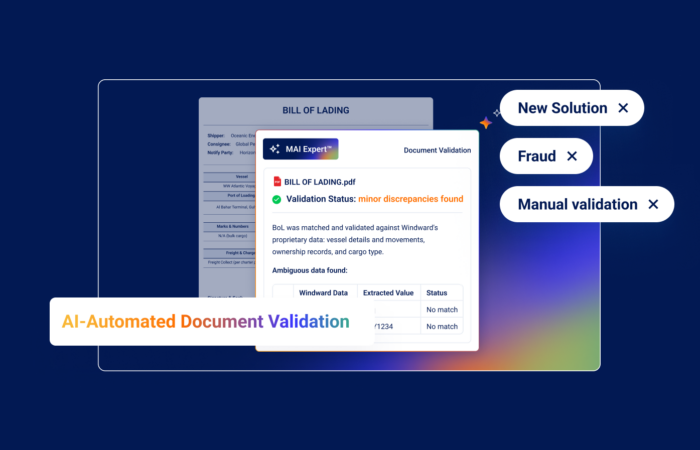Telltale signs a flag is going bad: An analysis of the Cameroon flag fleet

What’s inside?
In recent months, the flag of Cameroon has been starting to show up in the news leading us to take a deeper look into how monitoring flag registries and vessel flags can preemptively minimize risk and aid governments, flag and port authorities, and even commercial organizations identify flag weaknesses that illicit players and sanctioned regimes are exploiting.
It’s no secret that flag registries have again and again hit the headlines and come under criticism, much of which has centered around the practice of flags of convenience, their susceptibility to abuse by illicit players, and insufficient flag state regulations and enforcement. There are valid economic reasons for flags of convenience, but while some registries move to protect their flag, as was the case of the Panamanian flag registry when it moved to de-flag 60 vessels following sanctions-related activities, others have lost control over their flags and fleets. Governments have also recognized that not all flags are created equal and instituted port state controls such as the Paris MOU. But while port state controls and de-flagging are crucial to maintaining maritime standards, they are reactive designations applied only after damage has already been done.
Flag red flags: An analysis of the Cameroon flag fleet
If a tree falls in a forest and no one is around to hear it, does it still make a sound? Yes. Likewise, if a flag is being systematically exploited, there are telltale indicators that can point to hidden risks.
Accelerated fleet growth
In 2018, only 14 new vessels were registered with the Cameroonian flag (according to data transmitted over AIS). With thousands of flag changes taking place yearly in a population of over 80,000 IMO vessels, the Cameroonian flag wasn’t the most popular. In the following year, this number grew more than 4 times when throughout the year, more than 60 vessels registered with the Cameroonian flag, it would seem the flag registry was gaining popularity. With more than 75 newly registered vessels, 2020 marked an 435% jump in two years for this relatively small flag registry.

Skewed fleet class composition
Fleet growth by itself is hardly a conclusive indicator. On the contrary, the Cameroon flag fleet growth tapered out from 2019-2020, which could indicate stabilization. Perhaps 2018-2019 marked a commercial change to the registry that made the Cameroon flag particularly attractive to shipping fleets? A deeper look at the fleet class composition doesn’t ease any doubts.
In 2018, the fleet showed a relatively flat class distribution, without any tankers registered. In 2019, it grew significantly, with the class division showing a surge of interest from cargo and fishing shipowners. Interestingly enough, in 2020, the year of COVID slowdowns and the most sophisticated deceptive shipping practices seen to date, the class division shows that while overall fleet growth slowed down, the tanker division took off. 27 of these new vessels were tankers, and more than half of them were crude oil carriers capable of transferring large quantities of oil across oceans. This is an additional flag given that as of 2018, 79.4% of the world’s crude oil reserves rested with OPEC members, #1 and #3 of whom are the sanctioned regimes of Venezuela and Iran, respectively.

Adverse media
During 2020, the Cameroon flag hit the news full tilt when a general cargo ship named the ARESSA was caught with the largest narcotics shipment in Aruba’s history. The vessel had registered with the Cameroon flag registry a year prior, in February 2019, and immediately after the flag hop its pattern of operations changed radically as it began to call on West African ports for the first time. In December 2020, the vessel embarked on a journey calling ports in Brazil, Suriname, Venezuela, and Aruba, where open sources suggest the drugs originated. Eventually, the vessel was apprehended in international waters with more than a ton of narcotics onboard.

Unfortunately, this was only the beginning. The new Cameroon fleet was in the news once again after five Cameroon flagged tankers were identified loading Venezuelan crude. These tankers were later sanctioned in January 2021 by the Trump administration.
Closing the gap with behavioral intelligence
Following the United Nations Convention on the Law of the Sea (UNCLOS), which came into effect in 1994, flag registries have a responsibility to see that their fleet complies with international regulation. But if fleet growth and class composition are not enough and adverse media is too late, what can registries do?
Strong tools can help close the gap and uncover potential indications of vessels involved in illicit activity. In the case of the Cameroon fleet, its security and compliance risk speak volumes. In the span of two years, the fleet’s risk assessment changed radically.
Security risk
From a border security perspective, the Cameroon fleet went from an aggregate risk score of 14% due to their behavioral and static indicators in 2018 to 47% in 2019 and 2020, respectively.
This is a drastic change both in the aggregate risk score, the absolute number of “risky” vessels, and the ratio of new “risky” vessels registering under the Cameroon flag. Windward’s security risk is an indicator that border protection and law enforcement agencies look-to to identify illicit activity. Still, regulators and the flag registries themselves can also utilize it to determine their exposure.
Compliance risk
Compliance risk is multifaceted. A vessel’s actions in sanctioned programs, its connections to sanctioned entities, and interactions with other risky vessels, are all important to consider.
Until 2020, the Cameroon fleet had 3 sanctioned vessels only one of which was a new addition. In 2020, the tables completely turned – with 75 new vessels in the fleet. 42% of these new vessels were flagged as high compliance risk by our system. Even before sanctions designations or finding their way into the news, these vessels exhibited deceptive shipping practices. In January 2021, the US government sanctioned an additional 3 tankers. Bringing the total Cameroon flag vessels sanctioned to 6; and 2021 has only just begun.
Keep the flag flying?
Yes, flags of convenience are a contended topic, but they’re here to stay. While the maritime ecosystem continues to develop checks and controls, criminals will always find a way. Sanctions designations and fines are only part of what we need to minimize risk proactively. Organizations need to expand their due diligence to go beyond sanctions list screening to identify deceptive shipping practices, including:
- Flag fleet behavioral intelligence
- Fraudulent flag abuse, otherwise known as fraudulent registries
- AIS spoofing, also known as false flagging
- Flag hopping – Defined by OFAC as “repeatedly registering with new flag states to avoid detection”
- AIS swapping – A recent development and derivative of false flagging, termed by the UN Panel of Experts in its final report and recommendations regarding sanction violations on the DPRK
Book your demo to learn how maritime AI can help your organization








![[Webinar] Cross border crime](http://windward.ai/wp-content/uploads/2021/02/Webinar-Cross-border-crime-500x284.png)






